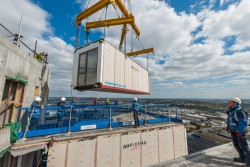"Government must support MMC both, directly through investment and indirectly through planning, education and construction and design quality standards and programmes, including encouraging and incentivising construction of MMC factories in areas of high unemployment as part of the Industrial Strategy," Tamara Hooper, Policy Manager for RICS said.
The stage is set for MMC homes to achieve scale. The concept has potency in the generation of a new model of home design, selection, and consumption especially in the submarkets of ageing population, social housing and build to rent.
Definitions of MMC
The diagrammatic gives various examples of the typologies, including timber frame, panellised and steel frame.
Social value
Faster delivery of MMC newbuild compared to traditional builds allows for them to be a greater server to the social housing sector, providing a premium as rental cashflow comes onstream sooner. Many housing associations are already utilising this new technique to deliver much needed housing, with some setting up their own production units.
As MMC is more adaptable/customisable housing authorities can also build more housing to meet the requirements of different participants, such as those with disabilities or the elderly. It is also being increasingly utilised in the build to rent industry as the customisable nature allows for standardisation, increasing yield and reducing voids and costs to users, as well as specification fit-out for frequent tenancy turnover including wider door sets and cassette replacements.
Offsite manufacturing requires a large investment up front and returns over the long term. If you have a factory, you must supply it with orders, so for modular to reach scale it will require a stable market. This is where the build-to-rent sector, local council housing including housing associations, and Homes England could stimulate offsite by committing to more offsite building developments. This would create growth within the industry achieving faster and increased delivery.
There is also opportunity for local housing companies (LCH) or housing authorities to become manufacturers and set up their own factories following the example of housing association's such as Swan Housing which has already successfully started to meet need and opened their own housing factory.
Traditional builds are generally not built with the four elements of accessibility and their upkeep means that adaptions to make them fit for an aging population are often of great cost.
Recommendations
Finance
This is an issue for investors, lenders, valuers and insurance/warranty providers naturally concerned about product durability, value and ongoing maintenance cost. The Build Offsite Property Assurance Scheme (BOPAS) constitutes a significant provider of confidence and assurance in this sector by warranting specific construction systems.
BOPAS accreditation of non-traditional build was one of the first systematic attempts to assist mainstream MMC. This offered durability and maintenance assessment carried out by Building Life Plans Ltd (BLP), process accreditation carried out with Lloyds Register, and a web-enabled database providing valuers, lenders and chartered surveyors with details of housing units by scheme.
Accreditation for MMC such as BOPAS needs to be championed and strengthened. Stakeholders need to be satisfied that there is an industry seal of approval which builds assurance for warranty providers and Insurers, as well as for lenders and investors. Accreditation models like BOPAS can help to mainstream MMC.
At the moment, the second-hand home sales process is clear and lenders have tolerances for bulk retail lending. Chartered surveyors and valuers also have a key role to play, and must add knowledge of MMC technologies, especially regarding their durability and cost in use, to their reporting skillset. We are therefore updating our guidance to reflect this by producing a new home survey standard to be released in autumn 2019 and updated valuation guidance.
Technology
The utilisation of pre-manufacturing technologies brings construction into the modern age by transferring production to the factory. With greater quality control and more efficient use of materials and labour, employing manufacturing techniques will boost productivity. This will enable faster scheme delivery with less risk of programme disruption on site, such as through bad weather. With scale, costs can be reduced through greater efficiency, delivered in a safer, controlled environment for workers.
Digitisation may be deployed both in the production process to achieve precision engineering and assembly, and through Building Information Modelling (BIM) (and successor models). BIM is a dynamic database which can track the unit through design, specification, procurement, construction/assembly, quality control and finishing, handover, letting/selling, residential occupation and management, repair, depreciation and replacement, and recycling and renewal. Digitisation has the potential to transform stakeholder confidence in the product including that of investors, manufacturers, builders, surveyors, lenders, insurers, managers, and, of course, consumers.
Performance will be much more closely monitored and scrutinised through digitisation and manufacturing. Through BIM, Prop Tech, big data, AI and the internet of things, performance can be tracked throughout the building's life. This means there is continuous data from design, manufacture, build, and management, which can feed back into design.
Government and industry must work together on the creation of apprenticeships and training products that support the rollout of MMC and encourage new entrants into construction. This must be funded and otherwise enabled strategically, including the encouragement of SMEs. This requires resourcing and incentivising new delivery agencies such as local authorities, local housing companies, special purpose vehicle's (SPV's) and joint ventures to recognise and utilise emerging technologies.









